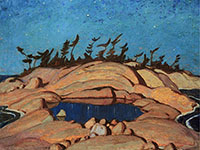CANADA HISTORY - Culture-Group of 7
Franklin Carmichael
Franklin Carmichael, a name etched into the annals of Canadian art, was born on May 4, 1890, in Orillia, Ontario. He emerged from modest beginnings, the son of a carriage maker. His early life, like that of so many artists who would later come to define their country’s artistic heritage, was rooted in the quiet rhythms of small-town life. Carmichael’s father, a skilled craftsman, undoubtedly influenced young Franklin’s appreciation for the fusion of beauty and utility, instilling in him a sense of precision and a respect for the materials that would shape his future. But while the carriage shop may have taught him the value of craftsmanship, Carmichael’s spirit yearned for something beyond the practicalities of wood and metal—he was drawn to the world of art, where form and color could transcend the material world and evoke deeper truths.
It wasn’t long before Carmichael’s burgeoning artistic talents became evident. After attending the Orillia Grammar School, Carmichael pursued his passion in Toronto, enrolling at the Ontario College of Art in 1911. There, he studied under the tutelage of figures like George Reid and William Cruikshank, artists who impressed upon him the fundamentals of art and design. Carmichael was also deeply influenced by his concurrent apprenticeship at Grip Ltd., a commercial art firm that employed several artists who would later join him in the Group of Seven. At Grip, Carmichael found himself surrounded by a vibrant group of young men who were similarly dissatisfied with the prevailing artistic conventions of the time. These artists, among them J.E.H. MacDonald, Arthur Lismer, and Tom Thomson, shared a common vision: to break free from the staid traditions of European art and create something that spoke to the rugged, untamed beauty of Canada.
Yet even as Carmichael’s artistic education progressed, it was a journey across the Atlantic that would further shape his vision. In 1913, Carmichael traveled to Belgium to study at the Académie Royale des Beaux-Arts in Antwerp. There, in the heart of Europe, he immersed himself in the vibrant artistic currents of the time, absorbing the lessons of Impressionism, Post-Impressionism, and modernism. But as much as these European styles shaped his technical skill, it was the contrast between Europe’s manicured landscapes and the raw, unspoiled wilderness of his homeland that truly inspired Carmichael. He returned to Canada in 1914, more determined than ever to capture the spirit of the northern landscape on canvas.
The outbreak of World War I, however, put artistic aspirations on hold for many. Carmichael found work as a commercial artist, but his passion for painting never waned. By the end of the war, Carmichael and his fellow artists, including Lawren Harris, A.Y. Jackson, and Fred Varley, had coalesced into what would become the most famous artistic movement in Canadian history. The Group of Seven, formally established in 1920, sought to create a distinctly Canadian form of art, one that reflected the harsh beauty and sublime isolation of the northern wilderness. Carmichael, the youngest member of the group, brought a fresh perspective to their shared mission. While his contemporaries often focused on grand, sweeping vistas of mountains and forests, Carmichael was particularly drawn to the smaller, more intimate landscapes of northern Ontario, especially the rolling hills and rural villages of the Georgian Bay and Algoma regions.
One of Carmichael’s most distinctive contributions to the Group of Seven was his mastery of watercolors, a medium that set him apart from his peers. His watercolors, with their vibrant colors and delicate lines, captured the play of light and shadow in a way that few other artists could. His painting October Gold (1922) stands as a testament to his skill in this medium. The work, which depicts a hillside ablaze with the fiery hues of autumn, is both striking and subtle. Carmichael's use of color imbues the scene with a sense of quiet beauty, while his careful attention to detail speaks to his love of craftsmanship and design. In Autumn Hillside (1920), Carmichael’s brushwork reveals his deep connection to the land, with rolling hills rendered in rich, warm tones that evoke the very essence of the changing seasons.
Carmichael’s work often carried with it a meditative quality. While his contemporaries sought to capture the dramatic power of the wilderness, Carmichael’s landscapes spoke of serenity, of the gentle rhythms of nature that one could find in a quiet meadow or a secluded valley. His paintings often depicted a human presence within the landscape, whether in the form of a distant farmhouse or a winding road, suggesting a harmony between man and nature that was central to his vision of Canadian life.
Yet Carmichael was not content to limit himself to landscape painting alone. He was a man of many talents, and throughout his career, he sought to explore different forms of artistic expression. His work as a designer and teacher left a lasting legacy on Canadian art. In 1932, Carmichael helped to found the Canadian Society of Painters in Water Colour, an organization dedicated to promoting the medium that he so loved. Later, he joined the faculty of the Ontario College of Art, where he taught design and drawing for many years, mentoring a new generation of artists and encouraging them to explore their own visions of Canadian identity.
Carmichael’s work, both as an artist and as a teacher, helped to shape the cultural landscape of Canada. His devotion to the watercolor medium, in particular, opened new avenues for Canadian artists to explore, showing that this delicate, subtle form of painting could convey the grandeur and beauty of the land just as powerfully as oil on canvas. His emphasis on craftsmanship and design ensured that his works were not only aesthetically beautiful but also technically masterful.
As the years passed, Carmichael’s art continued to evolve, but his love for the northern landscape remained constant. His later works, such as In the Nickel Belt (1931), reflect his ongoing interest in the interaction between industry and nature. Here, the rolling hills and towering trees of earlier works give way to the stark lines of a mining landscape, but even in these scenes of industrial encroachment, Carmichael found beauty. His ability to see beyond the surface, to capture the underlying spirit of a place, remained a hallmark of his work until the end of his life.
Carmichael passed away on October 24, 1945, leaving behind a legacy that would continue to inspire future generations of Canadian artists. His paintings, with their vibrant colors and intimate depictions of the land, captured the quiet beauty of the Canadian wilderness in a way that spoke to the soul of the nation. For Carmichael, the landscape was not merely a subject to be painted; it was a living, breathing entity, one that could evoke deep emotional responses in those who beheld it. His work, like that of the Group of Seven as a whole, helped to define what it meant to be Canadian in the early 20th century—a people connected to the land, shaped by its rhythms, and awed by its beauty.
In the broader context of Canadian art, Franklin Carmichael stands as a figure whose contributions were both profound and lasting. His watercolors, in particular, remain some of the finest examples of the medium in Canadian art history. His ability to capture the subtleties of light and color, his attention to detail, and his commitment to portraying the spirit of the land all speak to an artist who was deeply in tune with his surroundings. Today, Carmichael’s works are celebrated not only for their beauty but for what they represent: a love for Canada’s northern wilderness, a respect for craftsmanship, and a belief in the power of art to evoke the deepest truths of the human experience

















